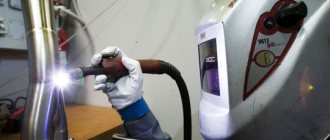Decarboxylation of carboxylic acid salts (Dumas reaction)
The Dumas reaction is the interaction of salts of carboxylic acids with alkalis during fusion.
R–COONa + NaOH → R–H + Na 2 CO 3
Decarboxylation is the removal (elimination) of a carbon dioxide molecule from a carboxyl group (-COOH) or an organic acid or carboxylate group (-COOMe) of a salt of an organic acid.
When sodium butanoate reacts with sodium hydroxide during fusion, propane and sodium carbonate are formed:
CH3–CH2 – CH2 –COONa + NaOH → CH3–CH2 – CH3 + Na 2 CO 3
Combustion of gases
When designing and operating gas-flame equipment, the question often arises of determining the optimal ratio of the amount of fuel and oxidizer, ensuring their complete combustion with the release of the maximum amount of thermal energy.Let's consider the method for determining the optimal ratio of the amount of fuel and oxidizer using the example: combustible gas - methane (CH4), oxidizer - oxygen (O2).
Methane/oxygen oxidation (combustion) reaction:
CH4+2xO2→CO2+2xH2O (1)
Molar mass of one molecule: hydrogen (H) – 1 g/mol, carbon (C) is 12 g/mol, oxygen (O) – 16 g/mol. Then, the molar mass of a methane molecule (CH4) is 16 g/mol, and the molar mass of an oxygen molecule (O2) is 32 g/mol. As follows from formula (1), for the complete oxidation of one molecule of methane (CH4), two molecules of oxygen (O2) are required.
Let us introduce the concept of the stoichiometric ratio [1] of oxidizer to fuel (by mass):
where m is the gas mass; ν—amount of substance, mol [2]; M – molar mass of gas; index “ok” - oxidizing agent; index “gg” – flammable gas.
The amount of a substance is determined in moles and characterizes the number of structural units (they can be atoms or molecules) of the substance being determined, referred to the number of structural units (atoms) in 0.012 kg (12 g) of the C12 carbon isotope. It follows from this that 0.012 kg (12 g) of the C12 carbon isotope contains one mole of the substance. The very number of structural units contained in one mole of a substance is called Avogadro’s number and is equal to NA = 6.023×1023 mol-1 = 6.023×1026 kmol-1 [2].
In this case, the amount of substance is determined by the ratio:
where N is the number of structural units (molecules) of substances participating in the oxidation reaction.
As mentioned above, one mole of any substance contains NA number of structural units, and each substance has a structural unit with its own mass (atomic mass, molecule mass). Therefore, one mole of a substance has mass; this mass is called molar mass. In this case, if a substance (in particular, a gas) has a mass m, and the number of structural units of this substance is such that the amount of the substance is ν, then:
Then, in the particular case of methane combustion in oxygen, we can write:
index “O2” - oxygen; index “CH4” – methane.
In practice, measuring gas mass is inconvenient and gas volume measurements are used. In order to determine the required volume of oxygen for the complete combustion of 1 m3 of methane, we write the equation of state [2] for each of the gases:
where p – gas pressure; V – gas volume; R – universal gas constant; T – gas temperature.
It should be noted that at the moment of the reaction the pressure and temperature of the gases will be the same.
Let us solve relations (5a) and (5b) regarding the volumes of the corresponding gases and determine the stoichiometric ratio of oxygen to methane (by volume):
Because the stoichiometric ratio of oxygen to methane for complete combustion is defined in (4), then we determine the following values for ratio (6):
In this case, the ratio of the volume of oxygen to the volume of methane is 2, i.e. To burn 1 m3 of methane, 2 m3 of oxygen will be required.
Relationship (6) can be written more universally:
Very often, gas-flame equipment uses air as an oxidizer, namely the oxygen contained in the air. According to the data given in [1], the percentage of oxygen in the air (by mass) is 23.2%. Let's write down the ratio:
where the index “vz” is air; If in relation (8) the numerator (oxygen mass) and denominator (air mass) are multiplied by the mass of the combustible gas that needs to be burned (oxidized), then we can proceed to the stoichiometric ratios (by mass):
To study the combustion process of methane in air, it is necessary to substitute the value into relation (9b)
then we get
those. For complete combustion of 1 kg of methane, 17.24 kg of air is required.
To determine the volume of air required to burn 1 m3 of methane, we use relation (7):
where MVZ = 29 g/mol [1].
In general, relation (10a) will take the form:
Substituting the values into relation (10b), we find that to burn 1 m3 of methane, 9.512 m3 of air will be required.
Propane (C3H8) and butane (C4H10) are also often used as flammable gases.
Oxidation (combustion) reaction of propane/oxygen and butane/oxygen:
C3H8 + 5xO2 → 3xCO2 + 4xH2O (11)
2xC4H10 + 13xO2 → 8xCO2+10xH2O (12)
Molar masses: propane – MC3H8 = 44 g/mol; butane – MC4H10 = 58 g/mol. Using the conclusions drawn for the oxidation reaction of methane and oxygen, we find that the required mass of oxygen (O2) for burning 1 kg of propane (C3H8) is 3.636 kg of oxygen (O2), and for burning 1 kg of butane (C4H10) is 3.586 kg of oxygen ( O2).
Then we can write:
Taking into account relation (9b), we determine that
those. To burn 1 kg of propane, 15.672 kg of air is required, and to burn 1 kg of butane – 15.457 kg of air.
Using relation (7) or (10b), we determine the volume of oxygen (O2) and air, which are respectively required to burn 1 m3 of propane and 1 m3 of butane, as shown in Table 1.
Table 1. Oxidizer consumption per 1 kg (1 m3) of combustible gas
| Propane (C3H8) | Butane (C4H10) | ||
| Oxygen (O2) | 4 kg (2 m3) | 3.636 kg (5 m3) | 3.586 kg (6.5 m3) |
| Air | 17.24 kg (9.512 m3) | 15.672 kg (23.779 m3) | 15.457 kg (30.914 m3) |
Propane (C3H8) and butane (C4H10) are most often used not separately, but as a mixture of flammable gases. Therefore, the required amount of oxidizer for complete combustion of the propane-butane mixture will depend on the percentage of each component.
Let γ be the fraction (by weight) of propane content in the mixture, and β be the fraction (by weight) of butane content in the mixture. γ and β are subject to the following relationship:
γ + β=1 (13)
Because propane and butane do not enter into chemical reactions, then the stoichiometric ratio for each gas will not change, and the stoichiometric ratio for a propane-butane mixture, depending on the oxidizer, will be determined by the ratio:
index “C3H8 – C4H10” – propane-butane mixture. The values of the stoichiometric ratios depending on the percentage of propane and butane in the mixture are presented in Table 2.
Table 2. Stoichiometric ratios (by mass) for propane-butane mixtures
| Oxidizing agent | Propane-butane mixture | γ = 0.7; β = 0.3 | γ = 0.6; β = 0.4 | γ = 0.5; β = 0.5 |
| Oxygen (O2) | 3,621 | 3,616 | 3,611 |
| Air | 15,607 | 15,586 | 15,565 |
In order to determine the ratio of the volume of the oxidizer to the volume of the propane-butane mixture, ensuring complete combustion, according to relation (7), it is necessary to determine the molar mass of the propane-butane mixture - MC3H8-C4H10. To do this, we use Dalton’s law [1]:
It must be taken into account that in Dalton’s law, both the temperature of each gas and their mixture, and the volume occupied by both the individual gas and their mixture, are the same.
Having expressed the pressure for propane, butane, as well as their mixture through the equation of state, similar to (5a) and (5b), we can move on to the following relationship:
Considering that
relation (16) can be rewritten:
The values of the molar masses of propane-butane mixtures for the most used ratios γ and β are given in Table 3.
Table 3. Molar masses of propane-butane mixtures
| Molar mass | Propane-butane mixture | γ = 0.7; β = 0.3 | γ = 0.6; β = 0.4 | γ = 0.5; β = 0.5 |
| MC3H8-C4H10 | 47,435 | 48,702 | 50,039 |
Then, in accordance with relation (7) or (10b), it is possible to calculate the stoichiometric ratios (by volume) for various propane-butane mixtures, which is shown in Table 4.
Table 4. Stoichiometric ratios (by volume) for propane-butane mixtures
| Oxidizing agent | Propane-butane mixture | γ = 0.7; β = 0.3 | γ = 0.6; β = 0.4 | γ = 0.5; β = 0.5 |
| Oxygen (O2) | 5,368 | 5,503 | 5,647 |
| Air | 25,529 | 26,175 | 26,857 |
It should be noted that the obtained values of oxidizer consumption (both by mass and volume) per unit of combustible gas should be increased by 2-5%, because There are other components in air and technical oxygen that, under the influence of high combustion temperatures, themselves enter into an oxidation reaction and thereby reduce the proportion of oxidizer in the combustible gas.
Also, according to [1] and [2], Dalton’s law and the equation of state are observed in the low pressure range. However, most gas-flame equipment is used at pressures up to 5 MPa, which makes it possible to apply both the obtained ratios and the given values.
Gas-flame equipment designed by Mashproekt LLC (website: mashproekt.rf E-mail: This e-mail address is being protected from spambots. You need JavaScript enabled to view it) ensures optimal combustion of flammable gases, such as in oxygen, and in the air. Therefore, our products have high fuel efficiency and, as a result, low operating costs.
BIBLIOGRAPHY
1. Glinka N.L. General chemistry – L.: Chemistry, 1979. – 720 p.
2. Savelyev I.V. General physics course. T. 1 – M.: Nauka, 1977 – 416 p.
Rational gas combustion and air protection
Protecting the air from pollution is one of the most important problems of our time. Industry and transport lead to air pollution with gas, smoke, carbon dioxide, chlorine vapor, dust from metallurgical and other industrial enterprises. Car exhaust fumes release lead and carbon monoxide into the atmosphere. Thus, one liter of leaded gasoline contains 200–500 mg of lead.
Converting cars to liquefied gas in large cities greatly helps clean up the air.
Another source of air pollution is the ever-increasing rate of consumption of various fuels. As its consumption increases, the amount of toxic and carcinogenic substances released into the atmosphere increases. It is known that when burning fuel, substances harmful to human health are formed: soot, ash, carbon monoxide, nitrogen oxides, etc.
The toxic substance is nitrogen oxide NO, one of the most dangerous air pollutants. Nitric oxide is formed in a flame, in a high temperature zone, by combining nitrogen with oxygen. At temperatures of 1500–1800 °C the highest concentration of NO is observed. The hot gases released into the atmosphere are cooled and nitrogen oxide is converted into nitrogen dioxide NO2. When they enter the human body, they are absorbed by the blood and have a harmful effect on the respiratory system. In our country, maximum permissible norms for the concentration of nitrogen oxides in the atmosphere of populated areas have been established (0.085 mg/m3). Combustion products must be removed through chimneys.
When burning solid and liquid fuels, carcinogenic substances can be formed that contribute to the occurrence of cancer. Fine dust is especially dangerous because it absorbs chemicals in the air and transfers them into the human lungs.
Soot, formed during the combustion process and carrying tiny particles of coal, can be a carrier of aromatic substances that cause various serious diseases. In this regard, humanity faces the most important problem of combating air pollution.
One of the most effective means of combating is the replacement of solid and liquid fuels with natural gas. Every year, thousands of industrial and municipal enterprises switch to gas fuel.
In order to reduce emissions of harmful substances into the environment and improve the purification of exhaust gases from harmful impurities, technological processes and vehicles are being improved everywhere, the production of highly efficient gas and dust collection devices, water treatment equipment, as well as devices and automatic stations for monitoring the state of the environment is being increased.
Environmental protection should become one of the most important tasks of any enterprise. Domestic and foreign practice of environmental protection shows that the main direction of this activity is not only control, but also prevention of harm and pollution of nature in the process of production activities.
The job description of the enterprise (or other responsible person) responsible for the gas industry must include materials on environmental protection activities, including:
- monitoring and regulation of emissions of gas combustion products;
- compliance with established environmental impact standards, gas use limits, environmental quality standards in the zone of influence of the enterprise;
- increasing the efficiency of gas fuel use;
- prevention of environmental accidents and emergencies;
- environmental information and professional training of personnel.
These and other activities must be reflected in the enterprise’s report on atmospheric air protection (Form No. 2 air).
Increasing the efficiency of gas fuel use
The efficiency of using gas fuel largely depends on its composition. Thus, for high-temperature processes it is advisable to use gas with a low ballast content and high heat output. In this case, the productivity of gas installations is increased and, by reducing the duration of the gas combustion process and reducing fuel losses into the environment, the specific fuel consumption per unit of output is reduced.
In many technological processes associated with air drying processes, an intermediate coolant is used - water vapor. Producing water vapor requires additional sources of heat, but meanwhile, gas combustion products can be successfully used for drying: then there is no need for special boiler installations and air heaters for heating air with steam.
It is known that when one cubic meter of gas is burned, two cubic meters of water vapor are released, leaving with the combustion products. If the condensation heat of these water vapors is used to heat feedwater, the efficiency of boiler plants can be increased.
Another reserve for increasing the efficiency of fuel use is the combustion of gas in burners at high thermal voltages, which makes it possible to obtain a larger amount of energy in a small volume.
Many technological processes take place at high flue gas temperatures. The efficiency of gas use in this case increases if the heat of the exhaust gases is used to produce steam, heat water or air. Every calorie put into a heated air furnace saves more than one calorie of heat from the gas being burned.
The most progressive method is the stepwise use of the heat of combustion products, based on a combination of low-temperature, medium-temperature and high-temperature installations.
The heat of flue gases removed from boilers and furnaces can be used to heat drying installations, and the heat of condensation of water vapor contained in gas combustion products removed from boilers or dryers can be used to heat water in contact economizers. Thus, combustion products removed from high-temperature plants are used in low-temperature processes to heat these plants; The efficiency of step units can be increased to 95%.
Gas combustion products can be successfully used as a source of carbon dioxide and inert gases. Of great interest is the use of carbon dioxide to accelerate plant development and increase yield. It is known that the organic mass of plants is formed by photosynthesis from CO2 and H2O.
The air atmosphere contains about 0.03% CO2 and 21% O2 by volume. Increasing the concentration of carbon dioxide in greenhouses, bringing its content in the air of greenhouses to 0.3%, allows you to increase the yield of cucumbers and other vegetables by 20%, by 50% - the number of flowers and accelerate their development, and increase the green mass of tobacco and tea by approximately 100%. , geraniums and other crops.
Enriching the air of greenhouses with carbon dioxide is important, since with the increase in the number of greenhouses and the use of hydroponics, in which there is no release of CO2 from the soil, the need for carbon dioxide increases significantly.
Clean combustion products of natural gas can be used for long-term storage of fruits and other food products.
The products of complete combustion of gas can also be used as inert gases for isolating flammable materials from contact with air, purging explosive equipment, and gas communications.









